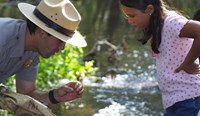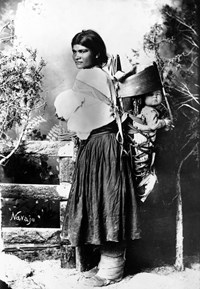- Lesson Plan (19)
- Traveling Trunk (7)
- Field Trips (1)
- Bent's Old Fort National Historic Site (11)
- Fort Larned National Historic Site (7)
- Santa Fe National Historic Trail (4)
- Everglades National Park (1)
- Gateway Arch National Park (1)
- George Washington Carver National Monument (1)
- Old Spanish National Historic Trail (1)
- Oregon National Historic Trail (1)
- Santa Monica Mountains National Recreation Area (1)
- Social Studies (24)
- Science (6)
- Literacy and Language Arts (2)
- Math (1)
Showing 28 results for fertilizer ...
A Long Way to Santa Fe
- Type: Traveling Trunk
- Grade Levels: Upper Elementary: Third Grade through Fifth Grade
Trading on the Santa Fe Trail
- Type: Lesson Plan
- Grade Levels: Upper Elementary: Third Grade through Fifth Grade

Overview: Kansas Historical Society offers a highly interactive exploration of life and culture on the trail through the use of a traveling resource trunk. The trunk provides educators with a variety of primary source documents, historical artifacts and photographs. The lessons focus on Kansas and United States history; Most lessons require the physical use of the trunk items.
- Type: Lesson Plan
- Grade Levels: Upper Elementary: Third Grade through Fifth Grade

This lesson is designed to review the purpose of the Santa Fe and Oregon Trails. The students will also expand their knowledge of each trail and put a plan together for a trip on each trail. This plan will include a packing list for their wagons. The students will use primary sources to help form their plans and packing list.
National Park Legacy - Battle the Bully Plants and Conserve Water! Grades 5 - 6
- Type: Lesson Plan
- Grade Levels: Upper Elementary: Third Grade through Fifth Grade

SMMNRA Nature Neighbor Project suggests native plant options for landscapes near natural areas. Native plants can generally resist weather challenges, require no fertilizer or pesticide and attract wildlife. Most importantly, plants native to Southern California are adapted to drought conditions and water is California’s most prized natural resource.
- Type: Lesson Plan
- Grade Levels: High School: Ninth Grade through Twelfth Grade

This lesson will look at the impact of artificially created fertilizers on the quality of the soil, especially in comparison with natural compost. Students will begin by creating their own compost. The “Compost in a Bottle Lab” is a long-term lab that should be started 3-4 weeks prior to beginning this lesson. Try to time it so that this lesson comes at the time when students are collecting their last set of data on their compost. Students also create a presentation product.
El Hombre
Old Bill Williams
Santafetrail.org Activities and Lessons
- Type: Lesson Plan
- Grade Levels: Upper Elementary: Third Grade through Fifth Grade

The Santa Fe Trail Association, the official partner of the Santa Fe National Historic Trail, offers a plethora of activities and packets for grades K-8. This site also offers a number of additional resources, including an interactive trail map with detailed explanations of each stop on the trail. Resources could easily be adapted to fit any curriculum!
No Pot of Gold
Letters From Sarah
A Tale of Two Towns
Dwellings of Fort Larned: An Earthy Experience
- Type: Field Trips
- Grade Levels: Upper Elementary: Third Grade through Fifth Grade
Old Spanish Trail Road Trip
- Type: Lesson Plan
- Grade Levels: Middle School: Sixth Grade through Eighth Grade
We’re off on a grand adventure: a road trip across the famous Old Spanish Trail! The Old Spanish Trail was an arduous 1,200 mile route between Santa Fe, New Mexico, and Los Angeles, California, which served traders who loaded their pack mules with woolen goods from Santa Fe each fall and returned from California each spring with goods, mules, and horses. The Old Spanish Trail linked two provinces of Mexico separated by difficult topography and climatic extremes.
George Washington Carver - An Original Conservationist: Sharing the Soil
- Type: Lesson Plan
- Grade Levels: High School: Ninth Grade through Twelfth Grade

For this activity students will create a brochure for farmers. The brochure will describe the needs each crop has (soil type, weather, etc.), the impact of the crop on the soil and the different ways the crop can be used. Students will focus on cotton, tobacco, peanuts, soybeans and sweet potatoes. The goal is for students to understand the impact cash crops may have on soil quality and how farmers can replenish their soil through crop rotation.
Heritage of the Southwest Traveling Trunk
- Type: Traveling Trunk
- Grade Levels: Upper Elementary: Third Grade through Fifth Grade
Cultural Dress
- Type: Lesson Plan
- Grade Levels: Upper Elementary: Third Grade through Fifth Grade
Business Ventures
- Type: Lesson Plan
- Grade Levels: Upper Elementary: Third Grade through Fifth Grade
Lewis Garrard's ten-month journey on the Santa Fe Trail put him in contact with merchants and traders during the 1840s when the political climate was shifting with Mexico. This lesson explores the risks, decision-making factors, and consequences of doing business in this region during the fur trade era.
Intercultural Kinship
- Type: Lesson Plan
- Grade Levels: Upper Elementary: Third Grade through Fifth Grade
Trade Goods
- Type: Lesson Plan
- Grade Levels: Upper Elementary: Third Grade through Fifth Grade
Trading Post Labor
- Type: Lesson Plan
- Grade Levels: Upper Elementary: Third Grade through Fifth Grade
Lewis Garrard's ten-month journey on the Santa Fe Trail produced a collection of observations that include the multicultural nature of labor in the southwestern borderlands in the 1840s. This lesson offers an opportunity to analyze the Bent, St. Vrain, & Company's dependence on skilled labor from various classes, ethnicities, and national origins.








